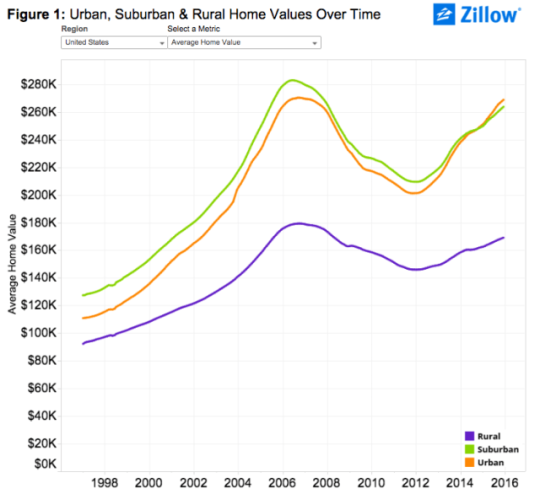Zillow.com recently published some research where they looked at U.S. home prices broken down according to location: urban, suburban, and rural.
Here’s what they found:

As you can see, urban homes across the U.S. largely trailed their suburban counterparts in terms of absolute value up until the end of 2014. At that point, urban homes then surpassed suburban homes for the first time in the last two decades. (I wonder if this is a first or there was another crossover point before the late 1990s.)
But if you dig a little deeper and look at both the rate of appreciation and prices per square foot (as opposed to just absolute value), urban home prices appear even stronger.
Here’s a snippet from Zillow’s post:
“Over the past five years (2010-2015), average urban home values have grown 28.4 percent, compared to 21.1 percent for suburban home values. In the past year alone, U.S. urban home values grew 7.5 percent, compared to 5.9 percent for suburban homes.
On a per-square-foot-basis, homes in urban areas nationwide used to be worth roughly the same as suburban homes, before a gap started emerging in the late 1990s which has become progressively wider over the past roughly two decades. Currently the gap stands at 24.5 percent, with suburban homes valued at $156 per-square-foot and average U.S. urban homes worth $198 per-square-foot.”
And here is that same chart showing per square foot prices:

Everyone who reads this blog knows that there is a growing interest in urban centers. But if you look at the above charts for specific cities, there are still many cases where urban home prices are well below suburban ones.
To me, that serves as a reminder of the spikiness of this urban transformation, but also that it is likely still in its infancy. As recent as 20 years ago, Toronto largely didn’t believe that people would want to live downtown in modern apartments. Today we take that for granted.
So even with all of the gushing about urban centers, I still think we are only just getting started when it comes to creating the great urban neighborhoods of the future.

Pingback: Analyse: Leveomkostningerne kan stige hurtigere for amerikanere på landet – MoneyLab.dk
Pingback: Commentary: The Unknown Impact of Inflation on Rural Americans - The Newark Daily Times
Pingback: Analysis: Cost of living may be rising faster for rural Americans – We Help Debt
Pingback: Evaluation: Cost of living may possibly be climbing more quickly for rural Americans - blogfromme
Pingback: Inflation Ignores Rural America? – Trego's Mountain Ear
Pingback: Rural Americans Aren’t Included in Inflation Figures – and For them, the Cost of Living May be Rising Faster - Summerlin Reporter
Pingback: Rural Americans Aren’t Included in Inflation Figures – and For them, the Cost of Living May be Rising Faster - Henderson Times
Pingback: Rural Americans Aren’t Included in Inflation Figures – and For them, the Cost of Living May be Rising Faster - Northern Clark County Herald
Pingback: Rural Americans Aren’t Included in Inflation Figures – and For them, the Cost of Living May be Rising Faster - Washoe Gazette
Pingback: Affordable Mortgage: Figuring out Your Home Affordability - Ark Homes